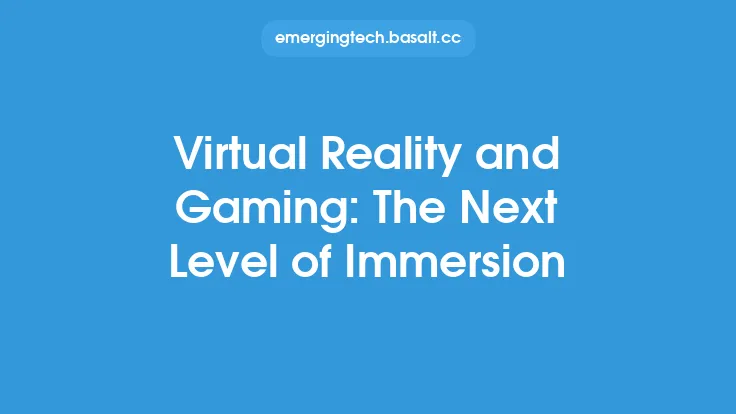The world of gaming has undergone a significant transformation with the advent of virtual reality (VR) technology. VR has revolutionized the way we experience games, providing an immersive and interactive environment that simulates real-world experiences. The impact of VR on gaming consoles and PCs has been profound, changing the way games are developed, marketed, and played. In this article, we will explore the effects of VR on gaming consoles and PCs, highlighting the benefits, challenges, and future prospects of this technology.
Introduction to Virtual Reality in Gaming
Virtual reality in gaming refers to the use of computer-generated simulations to create a three-dimensional environment that players can interact with. This technology uses a combination of hardware and software components, including head-mounted displays (HMDs), controllers, and sensors, to provide an immersive experience. VR gaming has been around for several decades, but it wasn't until the release of the Oculus Rift in 2016 that it gained mainstream popularity. Since then, VR has become a staple in the gaming industry, with many console and PC manufacturers incorporating VR capabilities into their devices.
Technical Requirements for Virtual Reality Gaming
To run VR games, gaming consoles and PCs require specific technical specifications. These include a high-performance processor, a dedicated graphics card, and a significant amount of memory. The processor must be capable of handling complex calculations and rendering 3D graphics in real-time, while the graphics card must be able to handle the high frame rates and resolutions required for VR. Additionally, VR games require a high-speed internet connection to download and update content. The technical requirements for VR gaming are constantly evolving, with new technologies such as ray tracing and artificial intelligence (AI) being integrated into VR games.
Impact on Gaming Consoles
The impact of VR on gaming consoles has been significant, with many manufacturers incorporating VR capabilities into their devices. The PlayStation 4, for example, supports VR gaming through the PlayStation VR (PSVR) headset, while the Xbox One supports VR gaming through the Oculus Rift and other third-party headsets. The Nintendo Switch also supports VR gaming, although its capabilities are limited compared to other consoles. VR gaming on consoles has opened up new possibilities for game developers, allowing them to create immersive and interactive experiences that were previously impossible. However, VR gaming on consoles also poses significant challenges, including the need for high-performance hardware and the limited availability of VR content.
Impact on PCs
The impact of VR on PCs has been equally significant, with many manufacturers incorporating VR capabilities into their devices. PCs offer more flexibility and customization options than consoles, making them a popular choice for VR gaming. PC-based VR systems, such as the Oculus Rift and HTC Vive, offer advanced features such as room-scale tracking and motion controllers, providing a more immersive experience than console-based VR systems. However, PC-based VR systems also require more powerful hardware and higher-end specifications, making them more expensive than console-based VR systems.
Benefits of Virtual Reality Gaming
The benefits of VR gaming are numerous, including increased immersion, improved engagement, and enhanced realism. VR games provide a more interactive and immersive experience than traditional games, allowing players to feel as though they are part of the game world. VR games also offer improved engagement, with players able to interact with the game environment in a more intuitive and natural way. Additionally, VR games provide enhanced realism, with advanced graphics and physics simulations creating a more realistic and believable game world.
Challenges of Virtual Reality Gaming
Despite the benefits of VR gaming, there are also several challenges associated with this technology. One of the main challenges is the high cost of VR hardware, including headsets, controllers, and PCs. VR hardware is often expensive, making it inaccessible to many gamers. Another challenge is the limited availability of VR content, with many games not optimized for VR. Additionally, VR gaming can be uncomfortable and even nauseating for some players, particularly those who are prone to motion sickness.
Future Prospects of Virtual Reality Gaming
The future prospects of VR gaming are exciting, with many new technologies and innovations on the horizon. One of the most significant developments is the emergence of standalone VR headsets, which do not require a PC or console to operate. These headsets, such as the Oculus Quest, offer advanced features such as room-scale tracking and motion controllers, providing a more immersive experience than traditional VR headsets. Another significant development is the integration of AI and machine learning into VR games, allowing for more realistic and dynamic game worlds. Additionally, the development of cloud-based VR gaming services, such as Google Stadia, is expected to revolutionize the way we play VR games, providing access to high-quality VR content without the need for expensive hardware.
Conclusion
In conclusion, the impact of VR on gaming consoles and PCs has been profound, changing the way games are developed, marketed, and played. While there are several challenges associated with VR gaming, including high costs and limited content, the benefits of this technology are numerous, including increased immersion, improved engagement, and enhanced realism. As VR technology continues to evolve, we can expect to see new innovations and developments that will further enhance the gaming experience. Whether you're a gamer, a developer, or simply a technology enthusiast, VR is an exciting and rapidly evolving field that is worth exploring.





